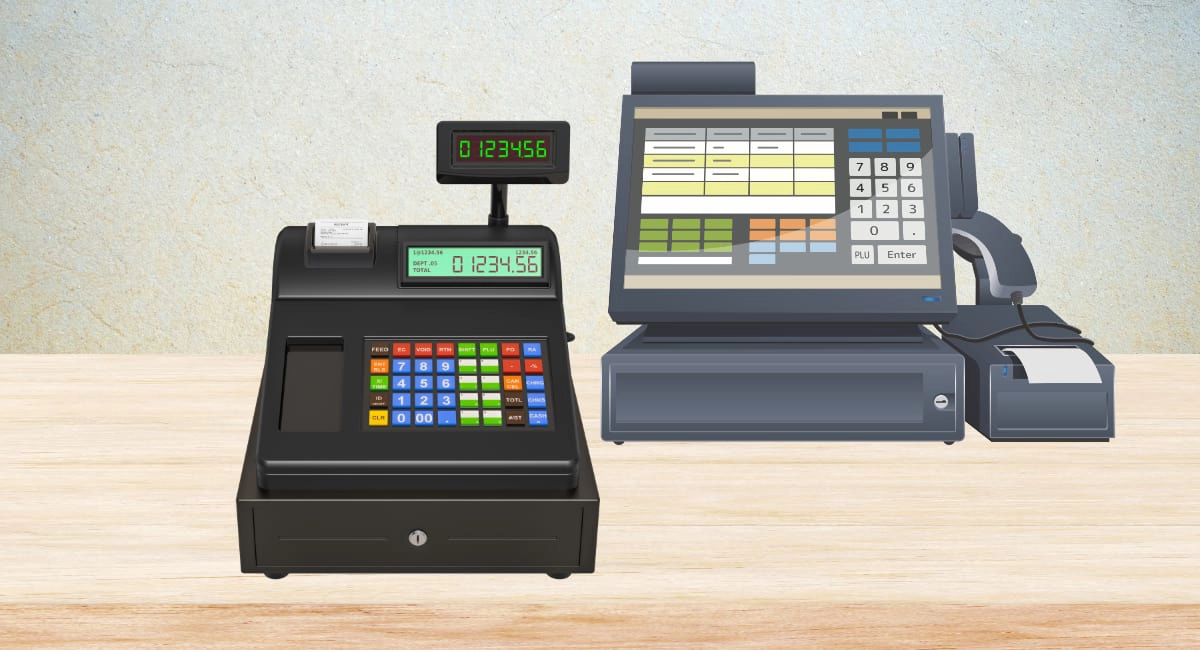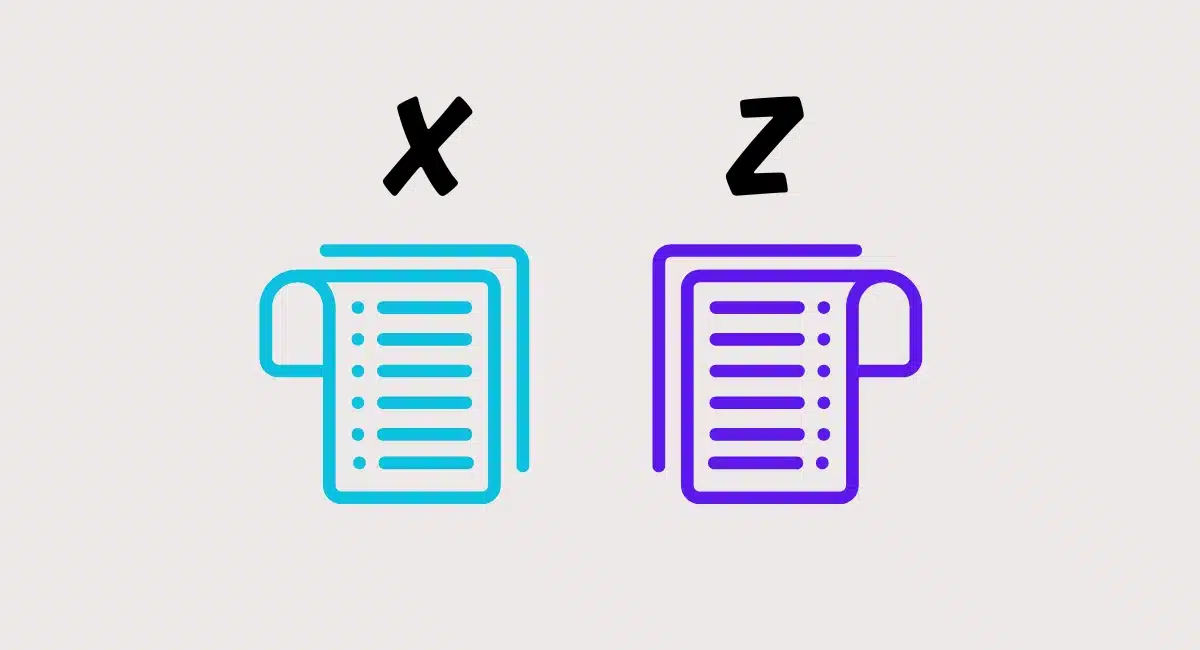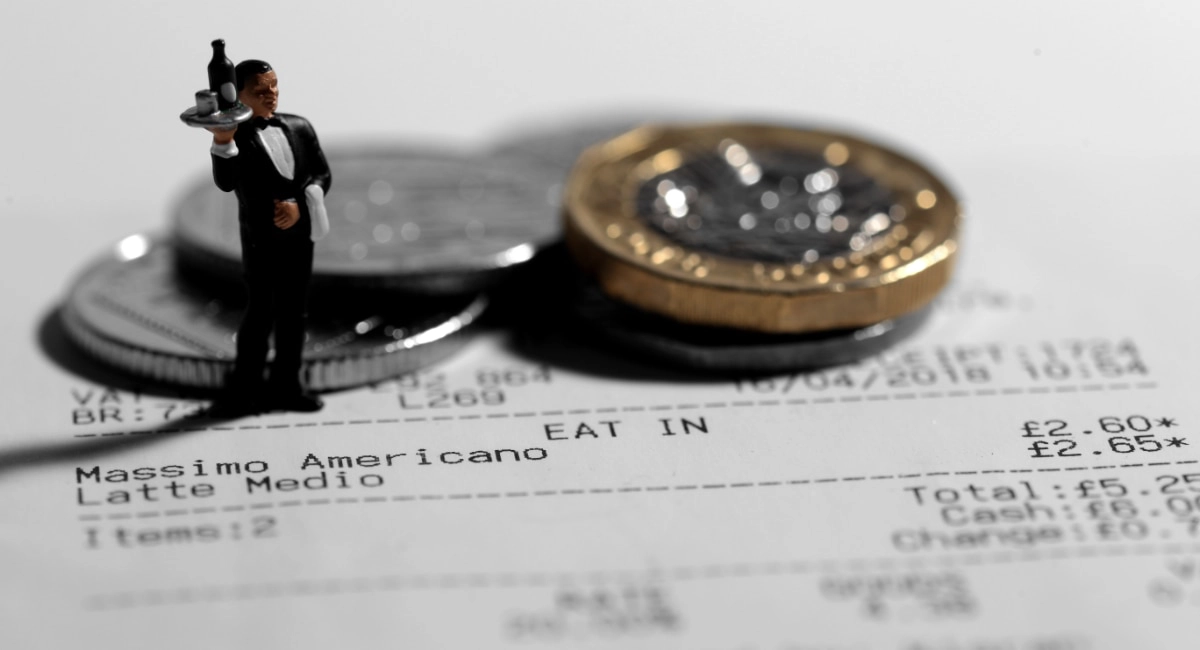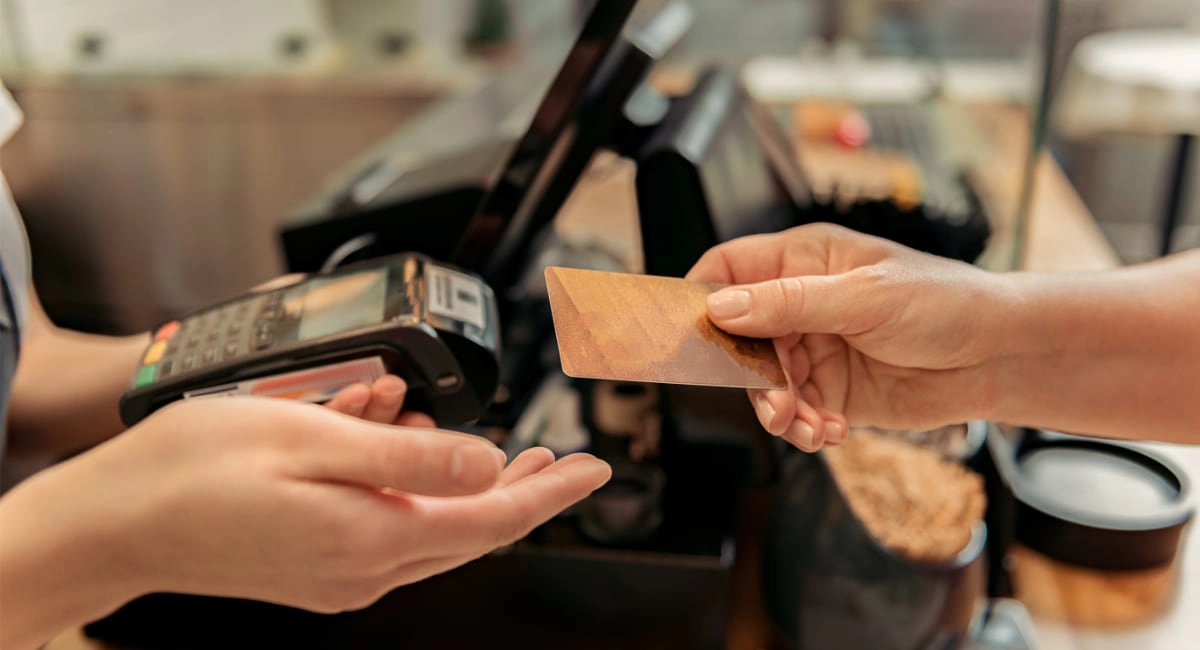A central part of brick and mortar business is the till, but there’s more than one type: cash registers and POS systems.
Cash registers used to dominate small shops, but electronic points of sale (EPOS), or POS systems as we shall call them here, are actually more cost-effective in many cases. That being said, a store that primarily accepts cash payments may prefer a cash register.
Let’s look at the main differences between a POS system and cash register, ending with our take on who should choose what.
Cash registers
As the name implies, a cash register is a piece of equipment for registering cash payments. A cash register only handles payment operations at the till. It is not connected to a computerised EPOS system, and it is limited what other till hardware it can integrate with directly.
Although the built-in cash drawer clearly makes it ideal as an all-in-one solution for cash payments, you can enter card transactions too by just pushing the appropriate button, after you have processed the card transaction on an independent card machine. Receipts, too, are also printed from the cash register. To sum up key features:
- A point of sale (POS) machine for registering transactions
- Includes a cash drawer
- With built-in receipt printer
- Has push buttons for entering sales
- Usually electronic with a display for seeing what you’ve entered
- Sometimes with customer-facing display
- Integrations with other features and hardware limited

Point of sale (POS) systems
A POS system is much broader in features than a cash register. Rather than being a till machine with inbuilt cash drawer and printer, a POS system comprises of different hardware components that are connected up. This includes a touchscreen display (could be a tablet), cash drawer, receipt printer, barcode scanner and card machine. For this to work, you need EPOS software that works in conjunction with your chosen equipment.
While the primary purpose is to process payments, a POS system is also a system of business features connected with your till transactions. This includes inventory library with stock levels that automatically update when you sell products, real-time reports accessible from a remote computer, staff timesheets and customer library with loyalty features.
In other words, it helps you to manage your business more efficiently, meaning less manual work and more tools to analyse how to sell more. These are the key features of POS systems:
- Equipment and POS software that form a till system
- Features help you manage your business, not just process sales
- Till buttons are on a touchscreen
- Software runs on a computer, tablet or mobile device
- Includes backend management functions accessed on a computer or in a web browser
- Typically comprised of separate till screen, cash drawer, receipt printer, barcode scanner and card machine
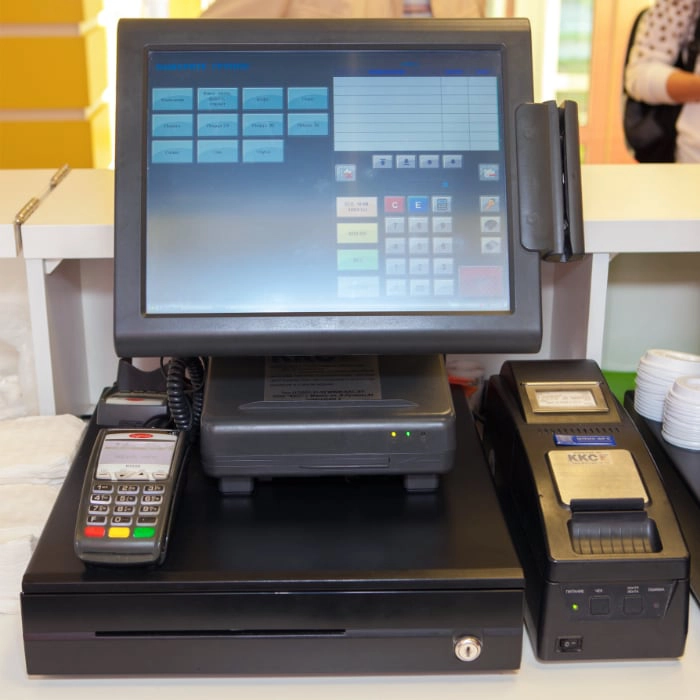
Equipment, software and costs
The most obvious differences between cash registers and POS systems are the costs and hardware components. What are the physical differences between the two till systems?
| Cash register | POS system | |
|---|---|---|
| Total equipment cost | £100-£240 incl. VAT + receipt paper | £800-£5,000 incl. VAT depending on hardware |
| Software cost | n/a | £0-£120 + VAT/month depending on software |
| Contract | None | Rolling subscription, with or without commitment |
| Receipt printer | Inbuilt | Separate, but can work with software |
| Cash drawer | Inbuilt | Separate, but can work with software |
| Displays | Built-in cashier-facing display showing entered items; sometimes also an inbuilt customer-facing display | Cashier-facing touchscreen; can get customer-facing display |
| Navigation | Push-buttons | Touchscreen buttons, sometimes computer mouse & external keyboard |
| Barcode scanner | Sometimes integrated with cash register | Separate, but can work with software |
| Card machine | Purchased/rented separately | Purchased/rented separately |
| Card acceptance | Need to set it up yourself; terminal not integrated with cash register | Sometimes part of POS system – if not, need to set it up separately; can be integrated or function independently |
| Cash register |
POS system |
|
|---|---|---|
| Total hardware cost | £100-£240 incl. VAT + receipt paper | £800-£5,000 incl. VAT depending on hardware |
| Software cost | n/a | £0-£120 + VAT/month depending on software |
| Contract | None | Rolling subscription, with or without commitment |
| Receipt printer | Inbuilt | Separate, but can work with software |
| Cash drawer | Inbuilt | Separate, but can work with software |
| Displays | Built-in cashier-facing display showing entered items; sometimes also an inbuilt customer-facing display | Cashier-facing touchscreen; can get customer-facing display |
| Navigation | Push-buttons | Touchscreen buttons, sometimes computer mouse & external keyboard |
| Barcode scanner | Sometimes integrated with cash register | Separate, but can work with software |
| Card machine | Purchased /rented separately | Purchased /rented separately |
| Card payments | Need to set it up yourself; terminal not integrated with cash register | Sometimes part of POS system – if not, need to set it up separately; can be integrated or function independently |
A cash register has the lowest start-up cost. The popular Casio SE-G1 cash register only costs £100 on Amazon, plus receipt paper which costs around £10 for a box of 20 rolls.
Compare that to a POS system where you have to buy a touchscreen device (iPads cost from £320), tablet holder (from £60), cash drawer (from £40) and receipt printer (from £120 + receipt rolls). This amounts to at least £540 for the absolute cheapest solution comparable to a cash register – excluding software.
Want to know more about prices? Here’s what a POS system costs including everything
Cash registers do not require electronic point of sale (EPOS) software, as the electronic functions are built into the machine. You don’t pay for that on an ongoing basis – but then, you don’t get ongoing customer support unless you pay for that service. In contrast, POS systems based in the cloud (most small-business POS today) are subscription-based, which includes ongoing customer support.
Lastly, card payments are an extra cost in both cases. Some POS systems include card processing via their own card readers, while others require you to set up a card acceptance contract from elsewhere. In the latter case, you may be able to integrate your chosen card terminal to the system if it is a compatible payment company, or just use the card machine independently and manually register successful card transactions in the EPOS system.
Cash registers don’t integrate with card machines, so you’re free to choose both a card machine and card processing and use that next to the cash register. When you then enter a sale, you pick card as payment method and may put a duplicate copy of the card machine receipt into the till drawer to prove the payment went through.
Till features
A way to distinguish cash registers from POS systems is obviously to see what they can do at the till point.
| Till function | Cash register | POS system |
|---|---|---|
| Accepting cash payments | ||
| Registering card payments | ||
| Adding VAT | ||
| Adding discounts | ||
| Refunds | ||
| Employee login | ||
| End-of-day reports (Z reports) | ||
| Product categories | 24-200 departments | Unlimited categories |
| Saved products for barcode scanning or manual entry | Up to 2000 products | Unlimited products |
| Customisation of receipts | Yes, typically a message, store name & phone number | Yes, various text and graphics |
| Cash register |
POS system |
|
|---|---|---|
| Accepting cash | ||
| Accepting cards | ||
| Adding VAT | ||
| Adding discounts | ||
| Refunds | ||
| Employee login | ||
| End-of-day reports (Z reports) | ||
| Product categories | 24-200 departments | Unlimited categories |
| Saved products for barcode scanning or manual entry | Up to 2000 products | Unlimited products |
| Custom receipts | Yes, typically a message, store name & phone number | Yes, various text and graphics |
A cash register can do the most important till functions a retailer would need. It accepts cash, card and cheques payments, and if you get one with a barcode scanner, you can even scan the barcodes of products you have saved on the cash register. The popular Casio registers can have up to 2000 products saved, although the cheaper SE-G1 model only saves up to 999 products. These can be divided into product categories.
POS systems typically allow you to save unlimited products, categories, options (e.g. size, colour) and pictures to display on the POS screen. This is much more adaptable since it can be changed any time from the screen, as opposed to a cash register that requires you to save everything on an SD card.
Refunds, discounts and adding tax is possible on a cash register and POS system. You can use employee IDs on a cash register, but POS systems allow you to set individual permissions for each staff account and track shifts and sales by employee as well.
Cashing-up reports with sales totals by department and tender – called Z reports – can be printed on cash registers, as can anytime sales reports called X reports. Receipts can be customised on a cash register, but only parts of the text can be edited. You can usually add company logo on a POS system receipt, plus any text you want. Furthermore, POS systems allow you to view and print sales reports in various formats, focusing on the things you need for accounting.
Business functions
What role do POS systems and cash registers play in the grand scheme of business operations? In the former case: quite a lot.
| Function | Cash register | POS system |
|---|---|---|
| Reporting & analytics | Can print sales totals sorted by department and payment method | Different kinds of reports can be viewed or printed from computer or tablet; advanced analytics |
| Accounting | Can integrate POS sales and employee data with accounting software | |
| Employee management | Individual staff accounts with custom permissions, staff analytics, digital timesheets | |
| Customer loyalty | Gift cards, promotions, marketing, customer profiles | |
| Inventory management | Digital product library with various options, stock level tracking, low-stock reminders, ingredient tracking (foods) | |
| Vendor management | ||
| Integration with ecommerce | ||
| Integration with cloud-based tools |
| Cash register |
POS system |
|
|---|---|---|
| Reporting & analytics | Can print sales totals sorted by department and payment method | Different reports can be viewed & printed from computer or tablet; advanced analytics |
| Accounting | Can integrate POS sales & employee data with accounting software | |
| Employee mgmt. | Individual staff accounts with custom permissions, staff analytics, digital timesheets | |
| Customer loyalty | Gift cards, promotions, marketing, customer profiles | |
| Inventory mgmt. | Product library with options, stock level tracking, low-stock reminders, ingredient tracking (foods) | |
| Vendor mgmt. | ||
| Integrated online store | ||
| Integrated cloud tools |
You can pretty much regard a cash register as separate from stock tracking, vendor management, accounting, customer loyalty initiatives, online store and anything else you have to do to run a shop. POS systems can do all those things (to varying degrees, according to chosen software), whether from the till screen, remote computer or mobile device if using a cloud-based POS system.
If you’re running a restaurant, the cash register won’t do you many favours. A POS system with hospitality EPOS, on the other hand, will have tableside ordering attached to transactions, ingredient tracking, table reservations and much more.
Some POS systems even have invoicing and phone payments included in their offering – not to mention the additional tools you can integrate with or upgrade to, depending on service provider.
This could save you money: Consider if cashless is beneficial for your business
What should you choose?
Now that you know the main differences, what should you decide to go for: cash register or POS system?
These are reasons to go for a cash register:
- Lower start-up costs and no monthly fees
- Your internet is not reliable, so need a system that works offline
- You’re a retail shop with less than 2000 products
- You accept more cash than cards
- You just want one machine to register transactions and store coins, bank notes and small documents
- You don’t mind handling businesses operations like inventory and staff management manually
Reasons to go for a POS system:
- You want a future-proof till system that is highly customisable
- You’re running a complicated business like a restaurant with table service or inventory-heavy retail store
- You want to automate business processes, ultimately spend less time on manual work
- You want to eliminate human errors by letting the system track stock and sales for you
- Your internet is stable (for cloud POS), or you can afford installation on your premises (for onsite POS)
- You want to be able to analyse sales trends down to the detail
Learn more: Which are the 5 best POS systems for iPad?

